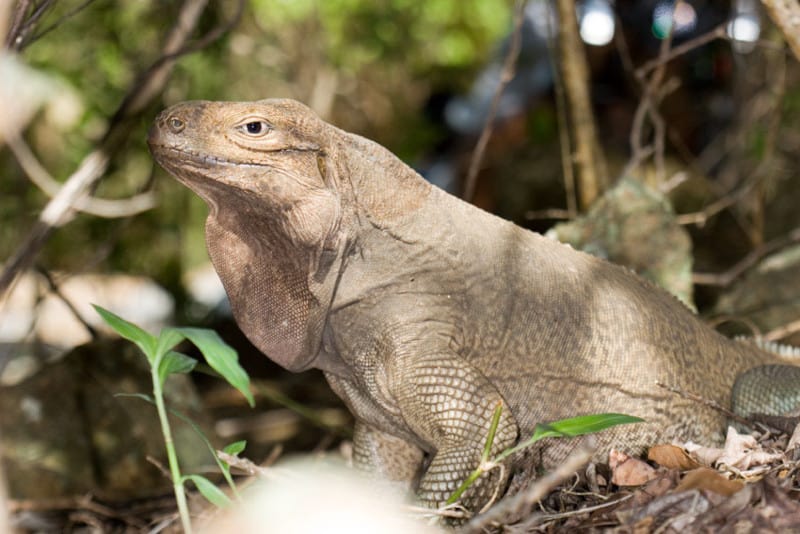Rough-nosed Horned-Lizard Facts
- Understandably, this intriguing reptile, with its distinctive appearance, most frequently goes by the common name of the Rough-nosed Horned-Lizard. However, like many species throughout the world, the remarkable animal also holds another generally used common name.
- In this case, that’s the much more informative term of the Sri Lanka horned agama. Scientific professionals, such as researchers, though, tend to more often use the formal scientific name when referring to it. But that’s the relatively simple name of the Ceratophora aspera.
- It received this designation due to the work of a respected researcher. The German-born British zoologist, Albert Charles Lewis Gotthilf Günther holds that distinction. That’s because he accomplished the first recognition of it as a separate and distinct species in 1864.
- Regardless of which term one chooses to use, however, it’s a fascinating product of evolution. Its unique physical attributes also serve to set it apart from all other known members of its genus. This situation only serves to enhance its particular appeal to researchers, though.
- Unfortunately, the fabulous Rough-nosed Horned-Lizard also seems to be dwindling rapidly in population. This regrettable trend further appears to hold true throughout the entirety of its known range. The IUCN, therefore, currently lists the astounding lizard as Endangered.
- Several factors now threaten it. Habitat loss due to human activities ranks high among those, to be certain. Its greatest threat, however, now comes from climate change. Its own very limited habitat range also serves to greatly augment the effects of each of these many dangers.
Related Articles



Rough-nosed Horned-Lizard Physical Description
Perhaps most incredibly, the Rough-nosed Horned-Lizard manages to pack all its intriguing characteristics into a surprisingly small body. That’s not completely unexpected , though. That’s because Nature holds no distinction regarding such unimportant factors as size and impressiveness.
The intriguing creature does, however, stand out from the other members of its Genus in one specific way. That’s where sheer physical size is concerned. That holds true due to the amazing fact that the animal only displays a moderate degree of the physiological trait of sexual dimorphism.
More specifically, this wonder of evolutioon manifests this aspect of its nature in the fact that females attain a slightly greater overall length than their male counterparts. This gender, though, only reaches lengths equaling about 1.6 in (4 cm). Yet the males remain moderately smaller in size.
This diminutive reptile also displays a visually striking pattern of natural coloring. This principally consists of a background composed of either dark yellow or light brown. A total of 17 darker bands, however, also extend from the head to the tail. The space between these shows a lighter shade.
Its body further develops to display a slightly compressed shape. Each individual also possesses a highly unique, x-shape dorsal ridge, located directly behind the head. The unique creature additionally develops a small crest, typically appearing along the region of the neck of the species.
The most noticeable trait of the Rough-nosed Horned-Lizard, though, remains the appendage to the nose of the creature. This marvel of natural processes distinguishes itself from its many related species yet again in this. That’s due to the fact the rostrum comprises up to 24% of the total length!
- Kingdom: Animalia
- Phylum: Chordata
- Class: Reptilia
- Order: Squamata
- Family: Agamidae
- Genus: Ceratophora
- Species: C. aspera
Rough-nosed Horned-Lizard Distribution, Habitat, and Ecology
The astonishing Rough-nosed Horned-Lizard has one natural attribute that unfortunately works against it. That’s the fact that this species evolved as indigenous to an extremely limited habitat range. Evidence indicates that it never existed anywhere outside that specific part of the world.
This holds true because it only appears within a tiny part of the overall portion of the earth’s surface consisting of southern Asia. In point of fact, the unique lizard lives only on one specific island. That’s the island comprising the nation of Sri Lanka, a site holding many other natural wonders.
Yet even there, its habitat preferences continue to limit its potential zone of habitation. Due to those strong preferences, the amazing reptile only dwells in areas of high moisture, with copious vegetation. This most frequently consists of forested regions, the greater the density the better.
It also demonstrates even more extensive levels of choice. The regions in which it chooses to make its home also tend to be predominantly comprised of local hardwood tree species. The great majority of individuals also seem to prefer to live at altitudes of no more than 2,953 ft (900 m).
Although the impressive Rough-nosed Horned-Lizard dwells amid so many trees, it’s actually not an arboreal species. Instead, the animal makes its home amid the copious quantities of leaf litter found on the ground. The lizard also tends to live in mated pairs, at least once it reaches adulthood.
This marvel of Nature also feeds quite indiscriminately, consuming a wide range of local prey. This dietary fare includes various insects and other small invertebrates. Following mating, the female later lays her eggs in a well-concealed nest. Typically, a clutch consists of two eggs for this species.
Species Sharing Its Range

Dugong


Check out our other articles on 5 Piedmont Region Invertebrates, Hellbender Salamander, Appalachian Mountains, Lesser Purple Emperor, Rough-toothed Dolphin, Rose Myrtle, Green Iguana











Leave a Reply